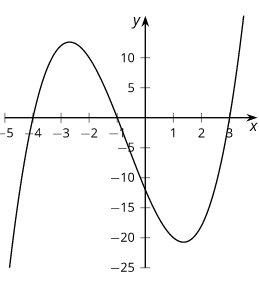Illustrative Math - Algebra 2 - Unit 2 - Lesson 8
By Formative Library
starstarstarstarstar
Last updated about 1 year ago
10 Questions
1
1.
Match each polynomial with its end behavior. Some end behavior options may not have a matching polynomial.
| arrow_right_alt | As x gets larger and larger in either the positive or negative direction, f(x) gets larger and larger in the positive direction. | |
| arrow_right_alt | As x gets larger and larger in the positive direction, f(x) gets larger and larger in the positive direction. As gets larger and larger in the negative direction, f(x) gets larger and larger in the negative direction. | |
| arrow_right_alt | As x gets larger and larger in the positive direction, f(x) gets larger and larger in the negative direction. As gets larger and larger in the negative direction, f(x) gets larger and larger in the positive direction. | |
| arrow_right_alt | As x gets larger and larger in either the positive or negative direction, f(x) gets larger and larger in the negative direction. |
A.APR.3
F.IF.7.a
1
2.
Which polynomial function gets larger and larger in the negative direction as x gets larger and larger in the negative direction?
A.APR.3
F.IF.7.a
1
3.
The graph of a polynomial function f is shown. Which statement about the polynomial is true?

A.APR.3
F.IF.7.a

1
4.
1
5.
1
6.

1
7.
1
8.
1
9.
Kiran wrote f(x)=(x-3)(x-7) as an example of a function whose graph has x-intercepts at x=-3,-7. What was his mistake?
A.APR.3
F.IF.7.a
1
10.
A polynomial function, f(x), has x-intercepts at (-6,0) and (2,0). What is one possible factor of f(x)?
A.APR.3
F.IF.7.a
This lesson is from Illustrative Mathematics. Algebra 2, Unit 2, Lesson 8. Internet. Available from https://curriculum.illustrativemathematics.org/HS/teachers/3/2/8/index.html ; accessed 27/July/2021.
IM Algebra 1, Geometry, Algebra 2 is © 2019 Illustrative Mathematics. Licensed under the Creative Commons Attribution 4.0 International License (CC BY 4.0).
The Illustrative Mathematics name and logo are not subject to the Creative Commons license and may not be used without the prior and express written consent of Illustrative Mathematics.
These materials include public domain images or openly licensed images that are copyrighted by their respective owners. Openly licensed images remain under the terms of their respective licenses. See the image attribution section for more information.